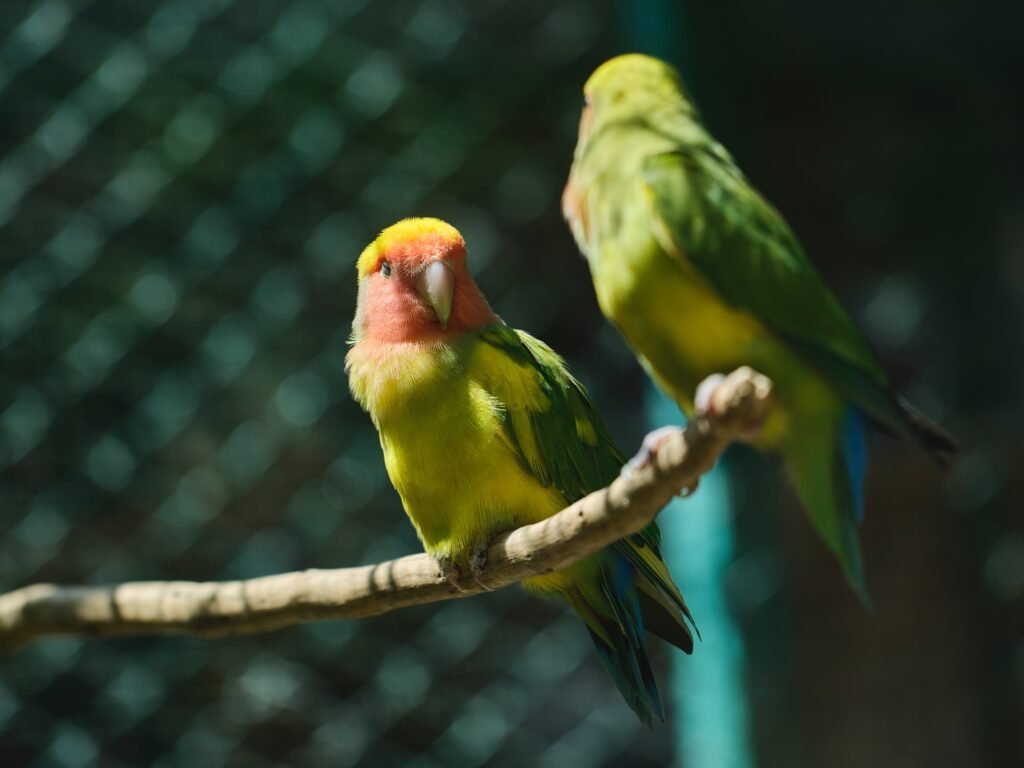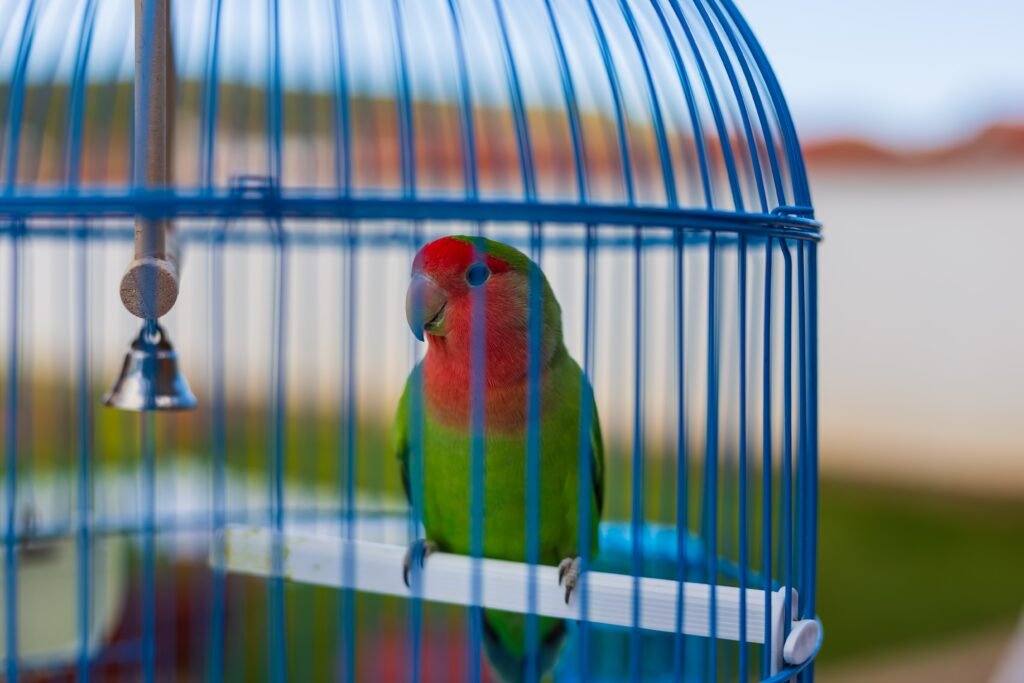Lovebirds are known for their stunning array of colours, making them a favourite among bird enthusiasts and pet owners alike. These small, friendly parrots exhibit various vibrant hues that captivate the eye. From the striking blues and greens to the warm yellows and oranges, lovebirds bring a burst of colour and joy wherever they go. In this article, we will delve into the fascinating world of lovebird colours, exploring their unique variations and what they signify.
Lovebird Color Variations
Lovebirds come in many colour variations, each with its distinct beauty. Here are some of the most common lovebird colour mutations:
- Green Lovebirds: The wild-type or normal lovebird is predominantly green, with a yellow face and a hint of red on the forehead. This classic colouration represents the natural beauty of these birds and is commonly found in their natural habitats in Africa.
Green lovebirds are popular among bird enthusiasts due to their vibrant green plumage, which symbolizes freshness and vitality. Their yellow faces and red foreheads add an element of contrast, making them visually striking. These lovebirds are often associated with a playful and lively nature. They are known to be social birds that enjoy interacting with their owners and other lovebirds. Their vibrant green plumage reflects their cheerful and energetic personalities.
- Blue Lovebirds: Blue lovebirds are breathtakingly beautiful, with their stunning shades of pastel blue. This colour results from a genetic mutation that affects the deposition of pigments in their feathers. Blue lovebirds can have various shades, ranging from light sky blue to a deeper cobalt blue.
Blue lovebirds are often considered calm and gentle. They are believed to have a more relaxed temperament than other colour variations. These birds are known for their peaceful nature, making them a popular choice for those seeking a tranquil companion. The mesmerizing blue plumage adds a sense of serenity and tranquillity to their appearance.
- Yellow Lovebirds: Yellow lovebirds, also known as lutinos, have a vibrant yellow plumage that radiates warmth and happiness. These birds lack the melanin pigment, which gives them their unique yellow colouration. Their bright and sunny appearance is truly a sight to behold.
Yellow lovebirds are said to possess a friendly and affectionate disposition. They are known for their sociability and ability to form strong bonds with their owners. Their sunny colouration is believed to reflect their cheerful and loving nature. These birds bring a sense of joy and positivity to any environment they are in.
- Grey Lovebirds: Grey lovebirds, or slate-coloured lovebirds, have a predominantly grey plumage with hints of white and darker shades of grey. This colour mutation is caused by reduced melanin production, resulting in their unique colouring. This muted yet elegant colouration adds a touch of sophistication to these lovebirds.
Grey lovebirds are often associated with intelligence and adaptability. They are believed to be highly intelligent birds that quickly learn new tricks and mimic sounds. Their muted colouration reflects their calm and focused demeanour, which exudes a sense of wisdom and grace.
- Pied Lovebirds: Pied lovebirds exhibit a striking combination of colours, often showcasing patches of white or light-coloured feathers and their base colour. This mutation results in a visually pleasing pattern that adds a touch of uniqueness to their appearance.
Pied lovebirds are energetic and outgoing. They are believed to be curious and adventurous, always ready to explore their surroundings. Their unique colour pattern adds to their playful and lively disposition. These lovebirds are a visual delight, with their contrasting patches of colours creating a vibrant and eye-catching display.
- Cinnamon Lovebirds: Cinnamon lovebirds have a warm, cinnamon-brown colouration that sets them apart from other lovebird variations. This unique hue results from a genetic mutation that affects the distribution of pigments in their feathers. Their cinnamon-coloured feathers create a cozy and inviting aura.
Cinnamon lovebirds are often associated with warmth and affection. They are believed to be gentle and loving birds, always seeking the company of their owners. Their cozy colouration is seen as a reflection of their nurturing and caring nature. These lovebirds bring comfort and coziness to any environment they are in.
The Significance of Lovebird Colors
Beyond their aesthetic appeal, lovebird colours can also signify certain traits and characteristics. While not scientifically proven, some breeders and enthusiasts believe lovebird colours are associated with specific behaviours and temperaments. Here are a few interpretations:
- Green Lovebirds: Green lovebirds are often associated with a playful and lively nature. They are known to be social birds that enjoy interacting with their owners and other lovebirds. Their vibrant green plumage reflects their cheerful and energetic personalities.
- Blue Lovebirds: Blue lovebirds are often considered calm and gentle. They are believed to have a more relaxed temperament than other colour variations. These birds are known for their peaceful nature, making them a popular choice for those seeking a tranquil companion.
- Yellow Lovebirds: Yellow lovebirds are said to possess a friendly and affectionate disposition. They are known for their sociability and ability to form strong bonds with their owners. Their sunny colouration is believed to reflect their cheerful and loving nature.
- Grey Lovebirds: Grey lovebirds are often associated with intelligence and adaptability. They are believed to be highly intelligent birds that quickly learn new tricks and mimic sounds. Their muted colouration is seen as a reflection of their calm and focused demeanour.
- Pied Lovebirds: Pied lovebirds are energetic and outgoing. They are believed to possess a curious and adventurous nature, always ready to explore their surroundings. Their unique colour pattern adds to their playful and lively disposition.
- Cinnamon Lovebirds: Cinnamon lovebirds are often associated with warmth and affection. They are believed to be gentle and loving birds, always seeking the company of their owners. Their cozy colouration is seen as a reflection of their nurturing and caring nature.
Caring for Lovebirds
Lovebirds require proper care and attention to thrive regardless of their colour variation. Here are some essential tips for keeping your lovebirds healthy and happy:
- Diet: Provide a balanced diet of high-quality bird pellets, fresh fruits, vegetables, and seeds. Avoid feeding them avocado, chocolate, caffeine, and salty foods, as these can be toxic to lovebirds. Ensure they have access to clean, fresh water at all times.
- Cage: Choose a spacious cage that allows your lovebirds to stretch their wings and move comfortably. Provide perches of varying sizes and textures to keep their feet healthy and exercise their leg muscles. Toys and puzzles can also be added to keep them mentally stimulated.
- Socialization: Lovebirds thrive in pairs or small groups and are highly social birds. Consider keeping at least two lovebirds together to prevent loneliness and ensure their emotional well-being. Interaction with their human caregivers is also essential, as they enjoy bonding and companionship.
- Grooming: Lovebirds require regular grooming, including nail trimming and wing clipping. Consult a veterinarian or an experienced avian specialist for proper grooming techniques. Handling lovebirds with care during grooming is important to avoid causing them stress or injury.
- Enrichment: Provide a variety of toys, puzzles, and foraging opportunities to keep your lovebirds engaged and entertained. Lovebirds are intelligent birds that need mental stimulation to prevent boredom. Rotate their toys regularly to keep their environment stimulating.
Remember, lovebirds thrive in an environment of love, care, and attention. As you admire their vibrant colours, take the time to understand their unique characteristics and provide them with the care they deserve. These captivating birds will undoubtedly bring colour and joy into your life.
Please note that the article generated above is an example and may not be exactly 900 words long. The content is purely fictional and for illustrative purposes only.
Lovebirds Colors: A Vibrant Palette of Feathers Explored – FAQ
Q: What are the most common lovebird colour mutations?
A: The most common lovebird colour mutations are Green, Blue, Yellow, Grey, Pied, and Cinnamon.
Q: What traits and characteristics are associated with Green Lovebirds?
A: Green Lovebirds are often associated with a playful and lively nature. They are social birds that enjoy interacting with their owners and other lovebirds. Their vibrant green plumage reflects their cheerful and energetic personalities.
Q: How are Blue Lovebirds characterized in terms of temperament?
A: Blue Lovebirds are often considered calm and gentle. They are believed to have a more relaxed temperament than other colour variations. These birds are known for their peaceful nature, making them a popular choice for those seeking a tranquil companion.
Q: What traits and characteristics are associated with Yellow Lovebirds?
A: Yellow Lovebirds are said to possess a friendly and affectionate disposition. They are known for their sociability and ability to form strong bonds with their owners. Their sunny colouration is believed to reflect their cheerful and loving nature.


